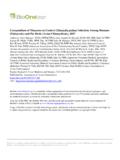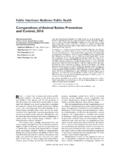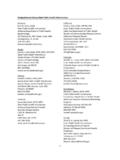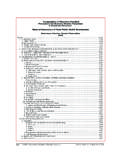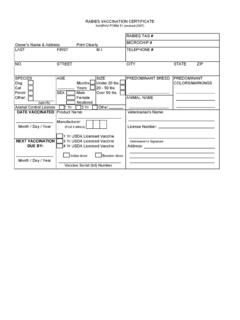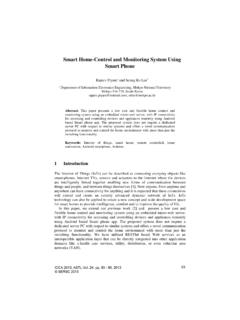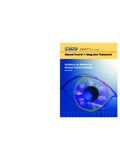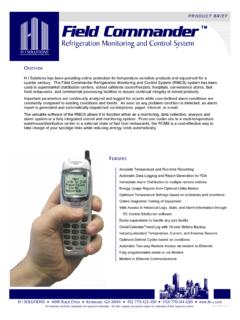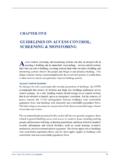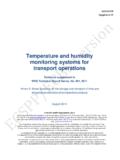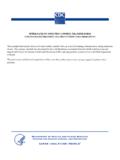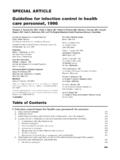Transcription of PROSPECTIVE SEROLOGIC MONITORING …
1 PROSPECTIVE SEROLOGIC MONITORING protocol : nasphv COMPENDIUM. OF ANIMAL RABIES PREVENTION AND control , 2016. This guidance on PROSPECTIVE SEROLOGIC MONITORING is for use with dogs and cats as referred to in Part I (4b) of the nasphv Compendium of Animal Rabies Prevention and control , 2016. NOTE: This guidance will be updated as needed. Please check the National Association of State Public Health Veterinarians website at for the most current guidance prior to any sample collection. This protocol applies only to a dog or cat;. that has been exposed to a confirmed or suspected rabid animal (as defined in Part I. of the Compendium), and;. that has been, or very likely has been, previously vaccinated with a USDA-licensed rabies vaccine, but for which there is no valid documentation, a rabies vaccination certificate, and;. whose owner or guardian wants to avoid euthanasia or strict quarantine, and;. that can immediately be managed by a veterinarian who can collect serum specimens as described below and administer a rabies vaccine.
2 The justification for this recommendation relies on the information presented in the following peer-reviewed publication: Moore MC, Davis RD, Kang Q, et al. Comparison of anamnestic responses to rabies vaccination in dogs and cats with current and out-of-date vaccination status. J Am Vet Med Assoc 2015;246(2):205 211. Dogs and cats that have previously received a USDA-licensed rabies vaccine which was administered in compliance with the manufacturers label insert, will mount a strong anamnestic (or secondary immune) response within days following the administration of a booster USDA-licensed rabies vaccine. The paper provides evidence that this is true regardless of the number of vaccines received (even a single vaccine) or the amount of time that has elapsed since the last vaccine was administered. Recommended protocol for jurisdictions choosing to permit the use of PROSPECTIVE SEROLOGIC MONITORING for decision-making regarding 4 month quarantine versus 45 day observation (see also Figure 1).
3 The dog or cat must be seen by a veterinarian immediately following an exposure to a confirmed or suspected rabid animal. The veterinarian must report the case to public health authorities or whatever entity which serves as the local Rabies control Authority (RCA). A. RCA is the government agency or official at the state or local level, legally authorized and responsible for enforcement of rabies laws, regulations, and ordinances in a specific jurisdiction. RCAs vary by jurisdiction but are most frequently public health, animal health, or animal control officials. The RCA should be provided all relevant details on what is known about the animal's vaccination history and the specifics of the current rabies exposure. The RCA. will determine whether PROSPECTIVE SEROLOGIC MONITORING is indicated and permitted in their jurisdiction. The RCA will work with the veterinarian and the owner to define a timeline during which the protocol must be implemented. The test, submission and all associated fees will be assumed by the animal owner and submitting veterinarian.
4 The veterinary visit in which the first serum is collected and the rabies vaccine is administered must occur as soon as possible following the exposure and should not exceed 96 hours post exposure. The date of this visit will be counted as Day 0. On Day 0: 1. Collect 1-2 mL of serum;. 2. Label and keep the serum specimen refrigerated until the second specimen is collected. Serum held for more than 7 days may need to be frozen. Follow the instructions provided by the laboratory that will be performing the tests;. 3. Administer a USDA-licensed rabies vaccine labeled for use in that species; and 4. Schedule a follow up appointment to ensure the pet will return in 5-7. On Day 5 (but no later than day 7): 1. Collect a second (paired) serum specimen (1-2 mL). 2. Label and store the specimen appropriately according to the instructions from the laboratory where it will be submitted;. 3. Submit the paired serum specimens to an approved Rabies Laboratory for Rapid Fluorescent Foci Inhibition Test (RFFIT) testing with the appropriate forms completed and carefully following shipping instructions provided by the laboratory; and 4.
5 Contact the RCA to document submission of the specimens. The paired serum specimens must be delivered to an approved Rabies Laboratory. At this time, the laboratories approved and available to perform the testing are: Atlanta Health Associates, Inc.;. Kansas State University Rabies Laboratory (KSU-RL); and Wadsworth Rabies Laboratory (for New York State residents only). The Centers for Disease control and Prevention (CDC) may occasionally provide testing services by special arrangement only. The definition of an approved laboratory is one that is currently licensed by CLIA or NYSDOH and has been approved to participate in this PROSPECTIVE Serological MONITORING protocol by nasphv 's Rabies Compendium Committee. The submission form for the appropriate laboratory must be complete, accurate, and accompany properly labelled paired specimens to avoid delays in testing. The submitting veterinarian is responsible for ensuring the accuracy of all specimen collection, submission form completion and shipping.
6 Turn around time for results are dependent upon the laboratory and their current testing volume. The submitting veterinarian is responsible for immediately contacting the RCA with the results to finalize recommendations for the animal. The dog or cat shall remain in strict quarantine during the testing process unless and until otherwise approved by the RCA. Interpretation of the results must be done in conjunction with the laboratory performing the testing as the determination of a statistically significant change in titer is determined by analysis of the laboratory's own data regarding testing performance. The test results will be used to determine whether the animal has evidence to suggest a previous rabies vaccine. Based on data analysis from the approved Rabies Laboratories, in general, the paired serum specimens must show both a statistically significant (usually defined as greater than two-fold at the currently approved Rabies Laboratories) rise in titer between the first and second specimens and the second titer must be above IU/mL.
7 If either of these conditions is not met, the animal must be treated as previously unvaccinated for the purposes of rabies control decisions. Serology test results do not pre-empt the authority of the RCA to order continued strict quarantine of the animal if it judges such actions to be in the best interest of protecting the public's health. Nor do these recommendations supersede any applicable state laws and regulations or local ordinances. FREQUENTLY ASKED QUESTIONS: 1. What if the dog or cat did not receive care immediately (within 96 hours) after the exposure? Such cases should be discussed with the RCA and managed on a case by case basis. Factors to consider include the number of days that have elapsed since the exposure, the severity of the exposure, number of previous vaccinations, the health of the animal and the local rabies epidemiology. 2. What if the dog or cat cannot return to the veterinarian for collection of the second specimen on DAY 5? The second specimens must be collected by Day 7.
8 Delaying collection of the specimen prevents accurate interpretation of the test results as any increase in rabies antibody titer might be due to the rabies exposure itself or the booster vaccination rather than an anamnestic response to a previous vaccination. 3. What test will be used to test the serum specimens? The laboratory will test the specimens using a Rapid Fluorescent Focus Inhibition Test (RFFIT). It is a serum neutralization (inhibition) test, which means it measures the ability of rabies specific antibodies to neutralize rabies virus and prevent the virus from infecting cells. These antibodies are called rabies virus neutralizing antibodies (RVNA). 4. What values will be used to determine if the dog or cat has evidence of a prior rabies vaccination and an acceptable anamnestic response? A greater than two-fold rise in the titer values of the paired specimens, as well as a RVNA titer equal to or above IU/mL for the second specimen, provides evidence of a robust anamnestic immune response after rabies vaccination.
9 Considerable variability exists as to any individual's response to vaccination and the RCA should consult the laboratory for help in interpreting results that fall outside these guidelines. If an anamnestic response is demonstrated, the animal should be issued a vaccine certificate with an expiration date consistent with the vaccine label. If there is no evidence of an anamnestic response, the vaccine is considered the initial dose and the animal should be boostered in one year, consistent with the vaccine label. 5. If the titer is equal to or above IU/mL and there is evidence of an anamnestic response, is it impossible for the animal to go on to develop rabies? A specific value equal to or above IU/mL and evidence of an anamnestic response suggests the animal will be protected. However, there have been rare instances in which vaccinated animals have gone on to develop rabies. Contributing factors may include other immunological factors involved in the protection from rabies infection, or the location, viral dose, and severity of the wound.
10 Because of this uncertainty, confinement with observation or quarantine is warranted regardless of the presence of antibodies. 6. Where can I find the appropriate submission forms and shipping instructions? Atlanta Health Associates, Inc.: Kansas State University Rabies Laboratory: laboratory/rffit- New York State Wadsworth Center (New York residents only): 7. Can this protocol be used for animals other than dogs or cats such as ferrets? No. At this time, data regarding anamnestic responses following revaccination with rabies vaccine are available only for dogs and cats. FIGURE 1: ALGORITHM FOR THE PROSPECTIVE SEROLOGIC MONITORING (PSM) protocol . ON MANAGING DOGS AND CATS EXPOSED TO RABIES WITH A HISTORY OF RABIES. VACCINATION, BUT NO DOCUMENTATION. Please Note, this protocol is intended only to apply to a dog or cat;. that has been exposed to a confirmed or suspect rabid animal (as defined in Part I of the Compendium), and;. that has been, or very likely has been, previously vaccinated with a USDA licensed rabies vaccine but for which there is no valid documentation, a rabies vaccination certificate, and.
